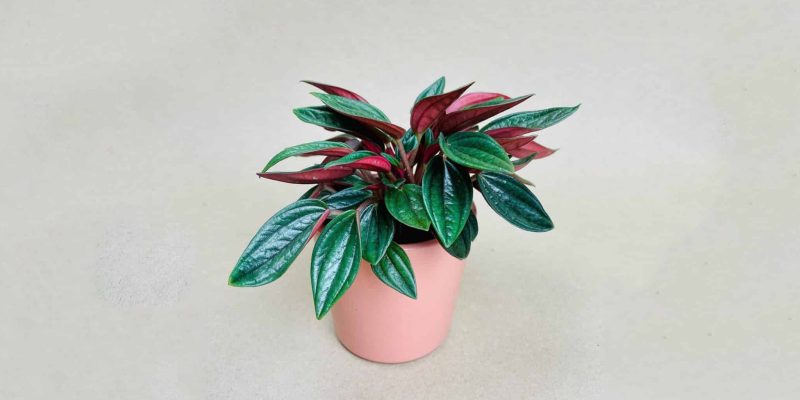Peperomia Rosso is the Hollywood starlet of peperomias. This diva will have your friends green with envy as they practically beg you for plant care tips.
You might think a plant this fabulous would require endless pampering and attention. But surprise, surprise, plant parents! Peperomia Rosso is as low maintenance as they come, making it a fabulous addition to your ever-growing plant family.
Ready to discover the secrets behind Peperomia Rosso care? Let’s dive into the world of this glamorous houseplant.
Table of Contents
Peperomia Rosso Plant Care Guide
History, Habitat, and Characteristics
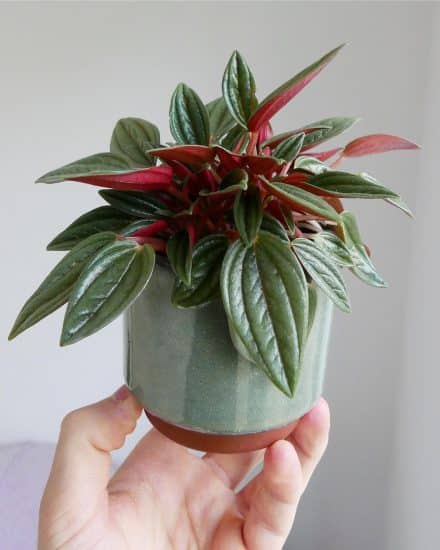
Peperomia Rosso (Peperomia caperata ‘Rosso’) is a an eye-catching houseplant with roots in the tropical regions of Central and South America, especially Brazil. As a member of the Piperaceae family, this little plant provides an intriguing combination of visual appeal and easy care.
The name of the game with Peperomia Rosso is texture. Its corrugated leaves are quite a spectacle, with rich green tops and vibrant red undersides. The Latin word caperata means “wrinkled,” a well-suited description for this plant’s deeply grooved foliage, and the source of this species’ common name, rippled peperomia.
To top it off, the leaves grow in a charming rosette formation, giving the impression of a flower when viewed from above. It’s this charming growth pattern that makes this peperomia an attractive dish-garden plant, as well as the fact that it typically grows to only 8 inches in height and width.
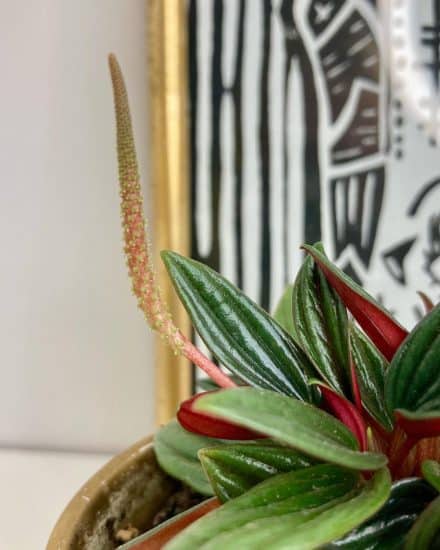
One of the key traits setting peperomia plants apart from other genera is their unique inflorescence. Rosso’s unforgettable foliage is accompanied by greenish-white, unscented flowers that sprout gracefully from the ends of reddish spikes.
With a whopping 1,700 species in the Peperomia genus, these little wonders often fly under the radar in both indoor and outdoor settings. But don’t let their size fool you! They’re highly adaptable and can thrive in tight spaces in nature, from craggy rocks on fallen logs.
Varieties
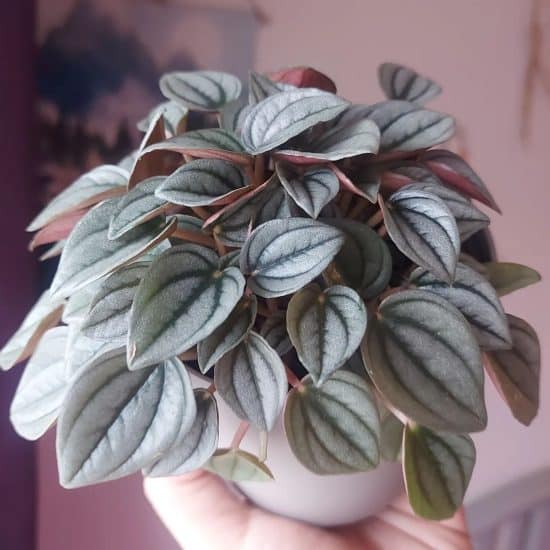
Peperomia Rosso shares similarities with several other Peperomia caperata varieties, each with its own distinct appearance, usually a unique color or leaf shape. Here are some of the other cultivars of Peperomia caperata ‘Rosso’:
- Peperomia caperata ‘Frost’: Known for its distinctive silvery leaves and compact nature.
- Peperomia caperata ‘Emerald Ripple’: This cultivar displays fully green leaves in the caperata’s typical compact fashion. Keep in mind that sometimes you’ll see Rosso described as “Emerald Ripple Red,” but this isn’t its own distinct cultivar.
- Peperomia caperata ‘Schumi Red’: Pale burgundy leaves set this caperata apart from its green and silver cousins.
- Peperomia caperata ‘Nigra’: A red so dark it’s almost black, this Peperomia caperata cultivar is surely the envy of all the other caperatas.
Light
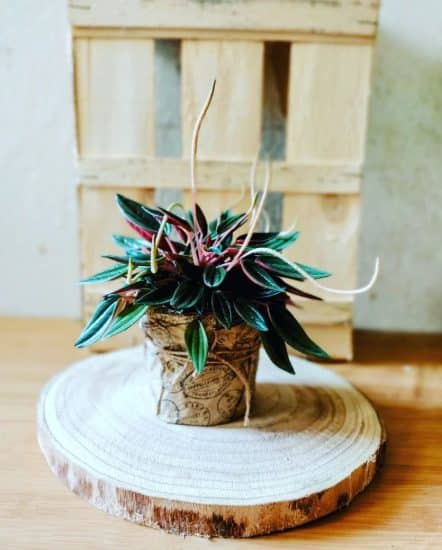
Peperomia caperata ‘Rosso’, your delightful radiator plant, shines brightly when given the right amount of indirect light.
Nestling your Peperomia Rosso near a sunny windowsill ensures it will bask in the gentle radiance of morning or evening sun. Not to worry, it’s also content under fluorescent or LED lighting! Just be mindful of strong direct sun, which can scorch the leaves and compromise your plant’s vibrant charm.
Now, if your Peperomia caperata ‘Rosso’ isn’t getting enough light, you might spot its dark-green leaves losing their striking colors and its growth turning slow and leggy. Conversely, too much direct sunlight can lead to scorched, faded, and brown leaves.
Our lighting tips:
- Choose bright indirect light, like the soft glow of morning or evening sunlight, to keep your Rosso plant healthy.
- Steer clear of intense direct light to prevent leaf damage.
- Should natural light be scarce, don’t fret — artificial grow lights are a fine alternative for this tropical plant.
Water
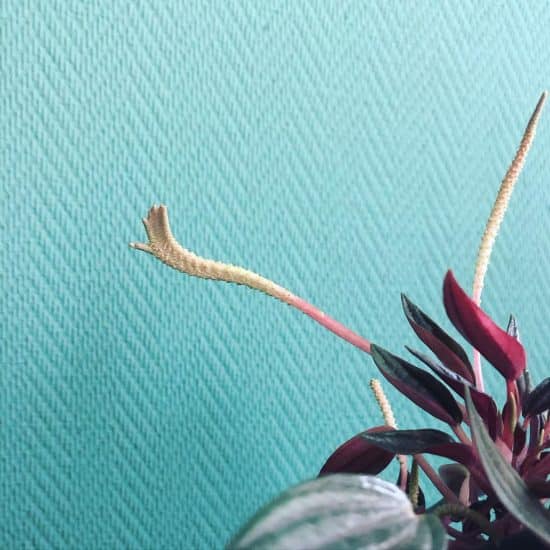
When it comes to watering Peperomia Rosso, finding the right balance is key because their shallow, delicate roots are sensitive to extreme conditions.
To ensure a healthy Rosso peperomia, wait until the top half of the soil feels dry before watering thoroughly. While we hesitate to give out exact timing because it can lead to over- or underwatering, you may end up watering your peperomia once every 7-10 days during the summer. In the winter season, reduce your watering considerably.
Avoid watering peperomias from the top or crown because the leaves are susceptible to rot if they stay wet. You can simply avoid the leaves, or you can opt for bottom-watering, which ensures even distribution and helps avoid stem rot. Just make sure not to leave your plant sitting in water too long. Less than an hour should do the trick.
Underwatering can cause Peperomia Rosso leaves to wrinkle and dry, giving the plant a wilted appearance. If you spot the signs of underwatering, simply increase the watering frequency while still monitoring the soil’s moisture levels.
On the other hand, signs of overwatering include yellowing leaves, mushy stems, and soil that stays wet. If you see these signs, reduce the amount and frequency of watering, allowing the soil to dry out before watering again. Always use pots with drainage holes, and be cautious of excess water accumulating in decorative cover pots.
Temperature and Humidity
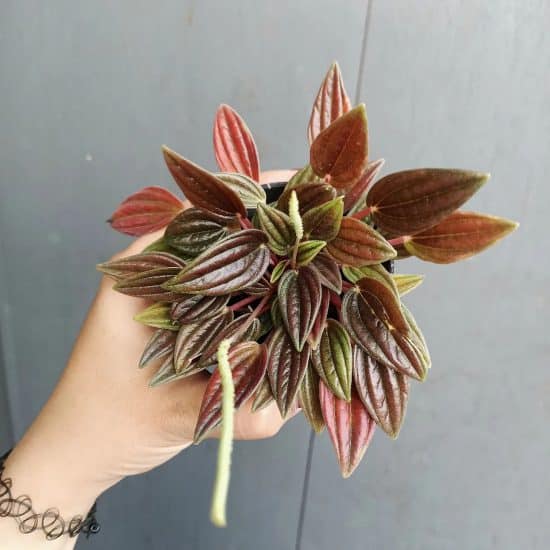
Peperomia Rosso, like other radiator plants, prefers a comfortable range of 50 to 80°F (13 to 24°C). Try to avoid exposure to extreme temperatures, which can create problems for your easygoing peperomia. Drooping leaves may indicate too-low temperatures, whereas dry or burned leaves suggest temperatures that are too high even for this tropical plant.
Humidity will come in handy when temperatures fluctuate. While these plants prefer higher humidity levels, they can also adapt to low-humidity environments. Aim for a humidity range of 40%-60% for optimal growth. If the leaves droop or have brown tips, the humidity level might be too low.
To increase humidity, run a humidifier nearby a few hours each day, or simply place your Peperomia Rosso plant on a drip tray filled with pebbles. When the water runs out of the drainage holes, the pebbles will retain the water but keep it away from the roots, and as the water evaporates, it’ll increase the humidity around your plant.
Soil and Planting
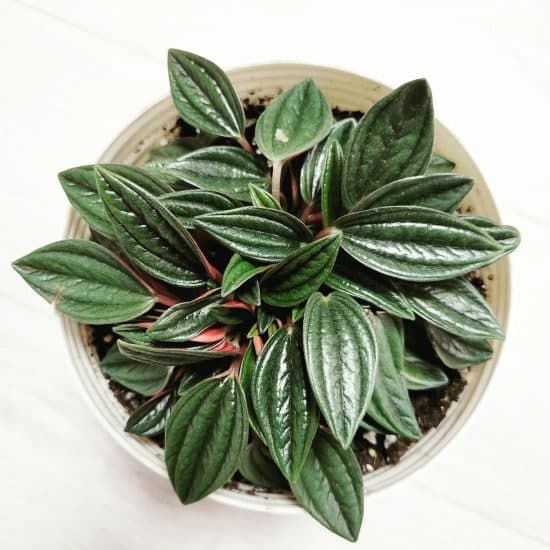
Peperomia Rosso plants prefer a well-draining potting mix that retains some moisture, similar to succulents.
Peperomias (radiator plants) don’t mind being root-bound and actually thrive in small containers, so don’t repot often. When you do, choose a pot with drainage holes and use well-draining potting soil. You can buy expensive premade mixes that claim to be perfect for succulent-type plants, or you can make your own.
Combine the following ingredients for a custom soil blend:
- Regular potting mix: Offers essential nutrients as the base of your soil mixture.
- Perlite: This improves drainage and aeration, preventing root rot.
- Coconut coir: Helps retain moisture while providing essential aeration, and is an eco-friendly alternative to peat moss.
Fertilizer
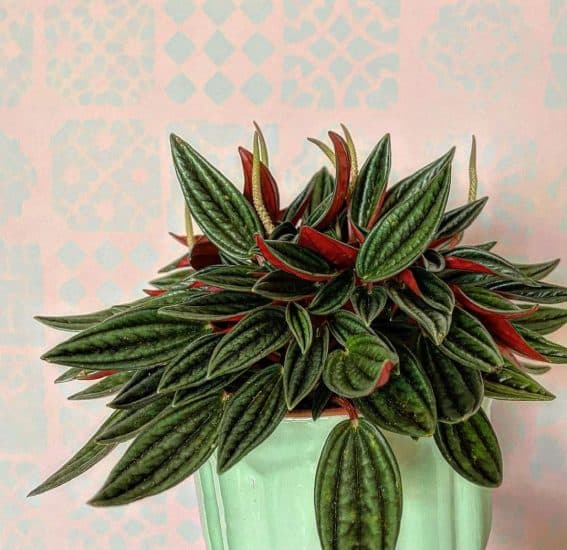
Fertilizing is not especially important for Peperomia Rosso, but you can fertilize once a month during the growing season if that’s part of your normal plant care routine or if you’re noticing exceptionally slow growth.
Wait six months before fertilizing a newly repotted plant or a recent purchase, then start applying the fertilizer in the first spring after this period. Use a balanced 10-10-10 fertilizer at half strength.
If you spot signs of too much fertilizer (such as leaf burn or yellowing), stop fertilizing and flush the soil with water to remove excess nutrients. Keep an eye on your plant and adjust your fertilization schedule as needed.
Propagation
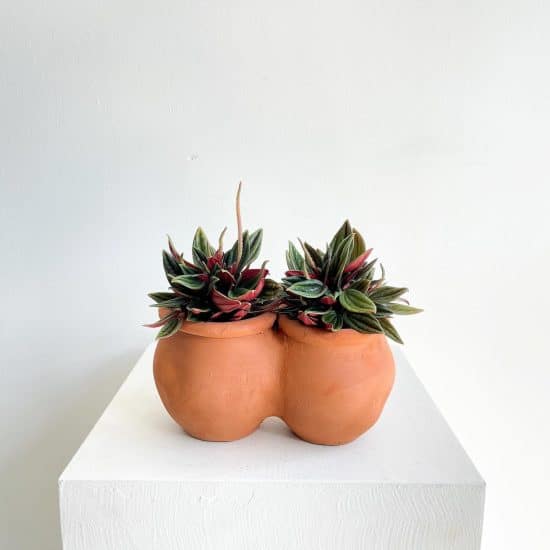
Peperomia Rosso can be easily propagated through leaf or stem cuttings in either soil or water. We’ll walk you through the steps for both techniques.
Propagating Peperomia Rosso via leaf cuttings in soil:
- Choose a healthy leaf from your Rosso peperomia, and with clean, sharp scissors or pruning shears, gently remove it from the plant.
- Slice the leaf in half to expose the dark-green veins on each piece. This trick increases the surface area for rooting and boosts your chances for success.
- Grab a pot and fill it with a blend of good-quality potting soil and perlite (more perlite than soil is good for propagating because it prevents too much moisture).
- Pop the leaf cuttings a few centimeters down into the soil, making sure the exposed veins are touching the medium.
- Keep it consistently moist while your cuttings work their magic.
- Cover your pot with cling film or slip it into a plastic sandwich bag to trap humidity, which will speed up the process.
- Find a bright spot with indirect sunlight for your pot, so your cuttings get the light they need.
- Mist regularly to ensure the cuttings stay hydrated and cozy while they develop roots.
Propagating Peperomia Rosso via stem cuttings in water:
- Pick a healthy stem on your Rosso peperomia, ideally with two to three vibrant leaves.
- Snip the stem just below a leaf node, using clean, sharp scissors or pruning shears.
- Strip the lower leaves off the bottom nodes, and you’re all set for rooting!
- Drop the stem cutting into a container filled with filtered water — just make sure no leaves are going for a swim!
- Place the container somewhere with bright sunlight, but out of direct light.
- Change the water every couple of days to keep things fresh for your cutting.
- Watch for roots to appear, and once they’ve grown around 2 inches long, it’s time to transplant your cutting into fresh potting soil. Keep the soil consistently moist for the first few weeks.
Common Issues
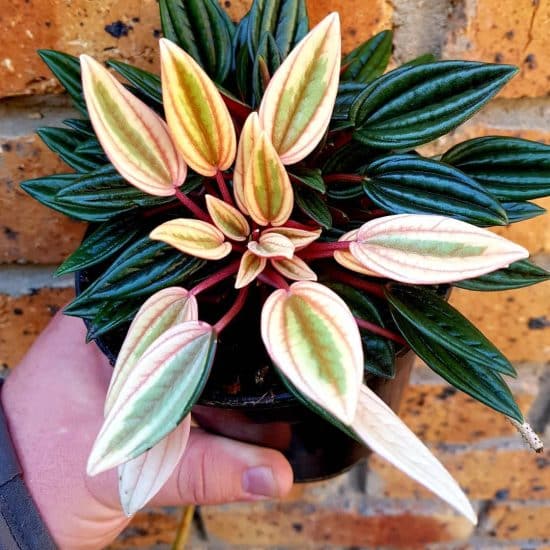
Repotting Stress
When repotting a Peperomia Rosso, it may become stressed, resulting in wilting, yellowing leaves, or slowed growth. As a slow-growing plant, to prevent repotting stress, keep the plant in its original nursery pot as long as possible and place it inside a decorative cache pot.
However, if repotting is necessary, let the plant acclimate to its environment before repotting, which can reduce the stress it experiences. Use well-draining soil and handle the plant delicately during the process. Make sure the new pot isn’t too much bigger than the old one — an inch or two larger should do.
Wilting and Dropping Leaves
If your Peperomia Rosso’s leaves begin to wilt or drop, it could be due to extreme water, temperature, or light conditions. Start by ensuring the plant is receiving bright, indirect sunlight and isn’t exposed to fluctuating temperatures ranging in extreme variations.
Next, evaluate the plant’s watering routine. Both underwatering and overwatering can cause wilting and dropping leaves. To maintain a healthy balance, water the plant only when the top inch or two of soil feels dry to touch, and make sure its pot has proper drainage to prevent overwatering.
Pests and Diseases
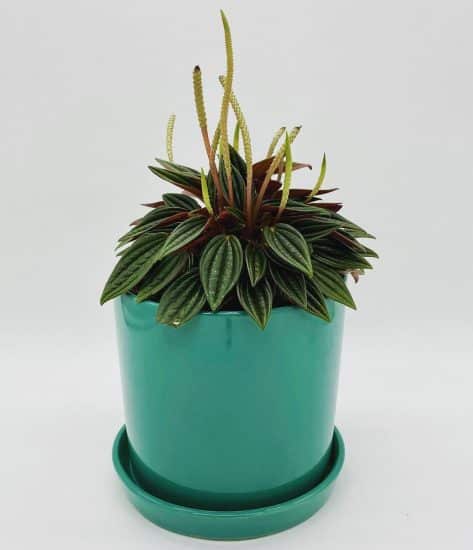
Stem Rot
Stem rot is a common problem for Peperomia Rosso, and it usually occurs due to overwatering or poor drainage. If you see black or mushy stems and leaves, it might be stem rot.
Here’s how to tackle the issue:
- Remove any rotting or dead leaves and stems, which can lead to diseases and attract pests.
- Make sure your plant has a good drainage system. Proper drainage holes are crucial, and the plant should never sit in standing water.
- Use a soil mix with added perlite or pumice when repotting. It allows for better aeration and drainage.
- Be mindful of your plant’s water intake. Let the top 1-2 inches of soil dry out before watering again.
- Cut down on the local humidity around your Peperomia Rosso plant.
Pests
While Peperomia Rosso is resistant to many diseases, pests like mealybugs, whiteflies, and spider mites can still appear. Keep an eye out for tiny bugs, webbing, or cotton-like substance on leaves and stems.
If you spot any bugs, follow these steps:
- Isolate the affected plant right away — this helps prevent the pests from spreading to other plants.
- Gently wipe off any visible pests from the leaves and stems using a damp cloth.
- For stubborn infestations, consider using insecticidal soap or neem oil. Dilute it according to the instructions on the label and spray it on your plant. Remember to cover both the tops and undersides of the leaves. Keep the plant out of sunlight while you’re treating it.
- Inspect your plant regularly, and repeat the treatment if necessary until those pesky pests are gone.
Conclusion
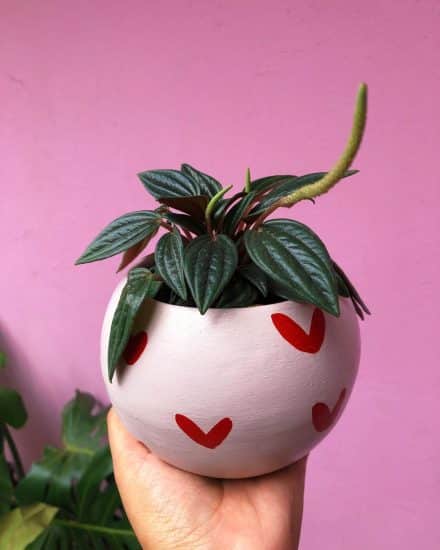
That’s it for our Peperomia Rosso guide! With its stunning red and green leaves, this charming houseplant is sure to add a touch of tropical flair to your indoor garden.
Peperomia Rosso care summary:
- Give it bright indirect light, avoiding direct sunlight to prevent scorching the leaves.
- Water only when the top 1-2 inches of soil feels dry, and use well-draining soil to avoid overwatering.
- Maintain a comfortable temperature range of 50 to 80 degrees Fahrenheit and a humidity level of 40%-60%.
We hope this guide has provided the knowledge and confidence you need to care for this delightful plant. And, as always, if you have any questions, don’t hesitate to reach out to us. Happy gardening!
FAQ
Is Peperomia Rosso toxic?
No. Peperomia Rosso plants are nontoxic to both cats and dogs, according to the ASPCA. This means that if your furry friends happen to nibble on a leaf or two, they should be perfectly fine. It’s still wise to keep an eye on your pets to ensure they don’t develop any symptoms — or kill your plant.
Can you bottom-water Peperomia Rosso?
Bottom-watering is a reliable method for watering Peperomia Rosso plants. Instead of pouring water on top of the plant or around the base, simply place the pot in a container filled with water and let the soil absorb it from the bottom up.
This approach ensures an even distribution of moisture, helping to prevent stem rot and other issues caused by overwatering. Just make sure you monitor the soil and take the pot out of the water when the soil has absorbed enough water, otherwise you risk root rot.
Is Peperomia Rosso a succulent?
Peperomia Rosso is considered a semi-succulent plant, which means it has some succulent-like characteristics. Its fleshy leaves store water, allowing the plant to endure periods of drought conditions with relative ease.

